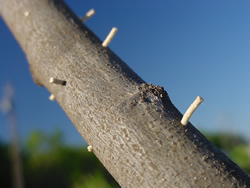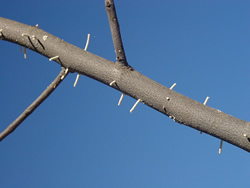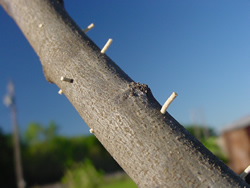| Question:
I saw a redbud tree in a nursery which had tooth pick-like
projections coming from the trunk and up and down most of
the limbs. What causes that?
Answer: I fear you
have witnessed the work of Asian ambrosia beetles. The Ambrosia
beetle (pictured at: http://easttexasgardening.tamu.edu/industry/aabplate.html
is a small, but deadly-to-trees insect, and it has the potential
to be a major pest in the nursery industry all across the
south. It has a wide host range of trees, mainly infesting
small diameter, smooth bark sections of trees. Peach, pecan
and plum orchards have been attacked, as well as nursery
tree stock.
The beetles bore into the trunk, leaving
tell-tale fragile spines of frass and sawdust sticking out
of trunks like toothpicks (Images attached). The beetles
cultivate a fungus (ambrosia) upon which the larval brood
feed. Infested trees usually quickly die.
A Texas Cooperative Extension Write-up:
ASIAN AMBROSIA BEETLE ATTACKING TREES
EARLY AND IN LARGE NUMBERS IN ET
Writer: Robert Burns (903) 834-6191
Source: Dr. James Robinson (903) 834-6191
EAST TEXAS -- Appearing three weeks
to a month early, the Asian ambrosia beetle could wreak
havoc among pecan, peach, plum and pear orchards, according
to an entomologist with Texas Cooperative Extension.
Alien to Texas a decade ago, the Asian
ambrosia beetle is now found in most all East Texas counties,
as far south as Corpus Christi and as far west as Dallas,
says an entomologist with Texas Cooperative Extension.
"Basically, it's now in about half
of Texas. The beetle is known to attack more than 100 species
of trees," said James Robinson, Extension entomologist
based at the Texas A&M University Agricultural Research
and Extension Center, Overton.
Robinson has had numerous calls from
Tyler as well as reports from Wood and Marion counties about
the early arrival of the beetle.
In past years, a number of East Texas
pecan producers lost one hundred or more trees to the beetle.
Though less than 1/8 inch long, the
Asian ambrosia beetle can kill a tree in a season. The beetle
burrows into the trunks of susceptible tree species. It
favors juvenile trees with trunks one- to two-inches in
diameter, but will also attack mature trees. Unlike most
other tree-infesting beetles, it prefers living trees over
dead wood.
As the beetle burrows into the tree,
it pushes a mixture of sawdust, tree sap and its own feces,
called frass, out behind it. The sawdust and frass harden
into a thin stick that juts out horizontally from the trunk
of the tree.
Robinson says the extruded sticks are
about as big around and as long as toothpicks. In fact,
that's what they most resemble except they are stark white.
The extruded sticks are telltale indicators of an Asian
ambrosia beetle infestation, for infestations by other species
of borers result in piles of dry sawdust at the base of
the tree.
Asian ambrosia beetles are hosts to
the ambrosia fungus. In a manner similar to some ants, the
beetles "farm" the fungus to feed to their brood.
Robinson speculated that the mild winter coupled with wet,
humid conditions have made an ideal environment for the
ambrosia fungus. More fungus means more larvae will be able
to feed and mature.
It is the fungus that represents the
health threat to the tree. The fungus plugs up the tree's
vascular system, that collection of tiny vessels that transports
water and nutrients to the plant cells.
Once a tree is infested, there are no
chemical controls that will save it. A tree may be infested
by a single beetle or by hundreds. For juvenile trees, one-
to three-years old, the infestation most often proves fatal.
Mature trees are more often likely to survive the infestation
but may serve as staging base for the beetle to attack nearby
younger trees.
For this reason, the general control
strategy is to cut down and destroy any infested trees immediately.
If local ordinances permit, burning the tree is the best
way to ensure the beetles are destroyed as well. If open
burning isn't permitted, and the tree is small enough, it
can be ground up and composted. You may also foil the beetle's
spread by burying the tree.
On trees that haven't been infested,
a dursban or diazinon spray may discourage the beetle, Robinson
said.
"But it's no guarantee that the
beetle's spread will be stopped. Burning infested trees
isn't a sure bet either, but right now it's the best control
measure we've got," Robinson said.
|







